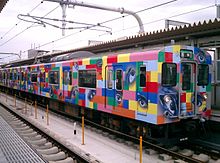For our last studio task for Richard before our practical sessions begin, we must create a list of 5 designers that relate to each context of practice lecture we have had throughout first year on the programme. We have 9 topics; modernism, postmodernism, street art/graffiti, film, high culture vs. low culture, typography and the history of type, media specificity, advertising and communication.
Postmodernism
Victor Moscoso
Professional lightning struck in the form of the psychedelic rock and roll poster for the San Francisco "Hippy" dance halls and clubs. Victor Moscoso's posters for the Family Dog dance-concerts at the Avalon Ballroom and his Neon Rose posters for the Matrix were to bring his work international attention in the "Summer of Love", 1967.
http://www.victormoscoso.com/about.htm
http://en.wikipedia.org/wiki/Victor_Moscoso
http://en.wikipedia.org/wiki/Victor_Moscoso
Tadanori Yokoo
Emigre
Emigre, also known as Emigre Graphics, is a digital type foundry, publisher and distributor of graphic design centered information based in California, that was founded in 1984 by husband-and-wife team Rudy Vanderlans and Zuzana Licko.
Emigre was founded in 1984 as an independent foundry, developing typefaces without an association to a typesetting equipment manufacturer. Coinciding with the advent of the Macintosh computer, Emigre took advantage of the new medium to design digital typefaces, as such they did not require the manufacturing infrastructure of a traditional type foundry.
Despite denunciation from traditionalists in the realm of design, Emigre became influential in the field. "People read best what they read most," was a manifesto that VanderLans and Licko held to when facing critics. Citing that what is deemed readable is only so because of the prevalence of a particular font.
Emigre not only designed type but also licensed over 300 original typefaces by many different designers.
http://www.emigre.com/
http://en.wikipedia.org/wiki/Emigre
Katherine McCoy
In 1971 McCoy began her career in design education when she was appointed co-chair of the Cranbrook Academy of Art graduate design program with her husband Michael McCoy.
Katherine claims she "combined the “objective” typographic approach that she knew through professional practice with an interest in the social and cultural activism that was in the air in the late '60s" when creating and reinventing the programme.
After 24 years of creative work, the McCoys left their positions in 1995. They moved to Chicago where they spent every fall semester at the Illinois Institute of Technology's Institute of Design, giving senior lectures and seminars until 2004.
http://en.wikipedia.org/wiki/Katherine_McCoy
http://www.highgrounddesign.com/mccoy/kmccoy.htm
http://www.aiga.org/medalist-katherinemccoy/
Barbara Kruger
American conceptual/pop artist Barbara Kruger was born in Newark, New Jersey in 1945 and left there in 1964 to attend Syracuse University. Early on she developed an interest in graphic design, poetry, writing and attended poetry readings.
After studying for a year at Syracuse she moved to New York where she began attending Parsons School of Design in 1965. She studied with fellow artists/photographers Diane Arbus and Marvin Israel, who introduced Kruger to other photographers and fashion/magazine sub-cultures. After a year at Parsons, Kruger again left school and worked at Condé Nast Publications in 1966. Not long after she started to work at Mademoiselle magazine as an entry-level designer, she was promoted to head designer a year later.
Later still she worked as a graphic designer, art director, and picture editor in the art departments at “House and Garden”, “Aperture,” and did magazine layouts, book jacket designs, and freelance picture editing for other publications. Her decade of background in design is evident in the work for which she is now internationally renowned. Like Andy Warhol, Kruger was heavily influenced by her years working as a graphic designer.
Barbara Kruger's graphic work usually consists of black-and-white photographs with overlaid captions set in white-on-red Futura Bold Oblique. The phrases usually make a bold statement and commonly use pronouns such as you, I, your, we and they. She juxtaposes imagery with text containing criticism of sexism/misogyny and cultural power structures.
Much of her text questions the viewer about feminism, classicism, consumerism, and individual autonomy and desire, although her black-and-white images are culled from the mainstream magazines that sell the very ideas she is disputing.
She layers found photographs from existing sources with pithy and aggressive text that involves the viewer in the struggle for power and control that her captions speak to.
http://www.barbarakruger.com/
http://en.wikipedia.org/wiki/Barbara_Kruger
http://www.arthistoryarchive.com/arthistory/feminist/Barbara-Kruger.html
Postmodern Imagery: Victor Moscoso, Tadanori Yokoo, Emigre, Katherine McCoy, Barbara Kruger

